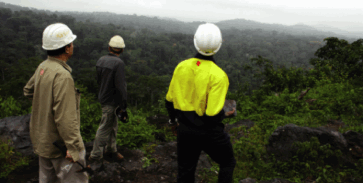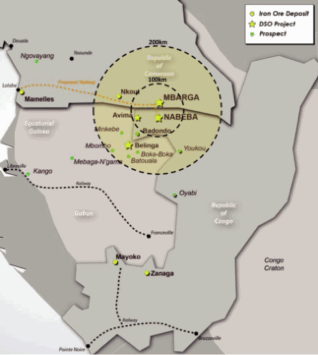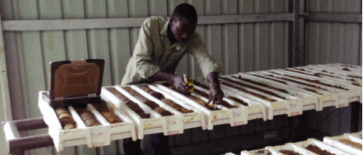Junior miner struggles to bring central African iron ore project into operation
Not many companies have had to endure the series of calamities that befell Sundance Resources on its way to build a huge iron ore mine deep in central Africa. While some may have been ready to write the company off, CEO Giulio Casello told E&MJ that Sundance is far from done.

Investors evaluate Sundance Resources’ project on the border of the Republic of Congo and Cameroon.
The Australia-based Sundance is advancing a 35-million-metric-ton-per-year (mt/y) mining project, which will straddle the borders of the Republic of Congo and Cameroon. The Mbalam-Nabeba complex intends to produce direct shipping ore hematite for a minimum of 10 years, with a second phase of 15-plus years producing high-grade itabirite hematite concentrate.
Situated far inland, the project will need 580 km of railway to connect it to a port—also to be built. Altogether the project will come in at under US$5 billion (the definitive feasibility study puts at A$4.7 billion), a hefty price tag at a time when much bigger rivals are cutting back capital investments.
In 2010, the entire board was killed when their chartered aircraft crashed in the Republic of Congo. A new team of executives had to be selected and the company forged on.
Sundance’s prospects appeared to brighten when Sichuan Hanlong, a Chinese industrial and investor group took a stake in the company and made a $1.43 billion takeover offer. Hanlong also brought the prospect of cheap funding from Chinese banks to the table.

Situated far inland, the project will need 580 km of railway to connect it to a West African port.
Before the deal could be closed, however, Hanlong needed to arrange finance through Chinese state-owned banks. A tedious and time consuming affair, Sundance board and shareholders had to sit back and be patient as the process unfolded and Hanlong’s bankers, as well as various Chinese state authorities, signed off on the deal.
As the months dragged on, investors began to grow uneasy. The disquiet turned to alarm last April when Hanlong missed payment of a convertible note to Sundance. Then, shortly afterward, Liu Han, chairman and owner of Hanlong and one of China’s richest men, was detained for allegedly helping a brother evade arrest for a 2009 murder, and investors panicked.
Sundance’s stock lost more than half its value in a matter of hours. The take-over appeared dead, and, it seemed, so was the project.
“It was disappointing the way it finished,” Casello said. “The key point is the transaction did not fail because of this project. The failure occurred with the unfortunate detention of the CEO of Hanlong, who is still not in a contactable position.”
Hanlong still holds around 14% of the company, which Casello said, was financed by Chinese banks. “We recently met with these banks in China, which went well, and we were reassured that they support our current strategy to develop the project. As far as we have been advised, there has been no mention of the intention to divest that stake at the current share price.”
Casello noted that the company’s stock turned over a billion shares in the weeks following Liu Han’s detention as investors fled. Hedge funds, he said, were especially quick to head for the door.
“The question was what to do next. So we talked to steel mills, iron or traders, and other potential iron ore buyers,” Casello said. “We issued a strategy but it did not make a big difference to share price.”
Investors were interested in the project but remained wary of Sundance’s ability to deliver. How, they wanted to know, would the company keep the doors open while it tried to raise the $5 billion it needed to get the mine into production?
Sundance then went ahead and issued a convertible note in October 2013, raising $40 million, the first step to restoring market faith in its ability to see the project through.
“Investors liked the strategy but wanted to know the company would stay afloat in the meantime…hence the float,” Casello said.
In the meantime, Casello remains confident the project has a future. The major producers such as Rio Tinto and BHP Billiton have mauled their project pipe-line—significantly sized planned iron ore mines have dropped to near zero. Eventually, when demand ticks up, as it must, pressure will be on the supply side.
The world will be short of iron ore by 2017, he predicted, and the Mbalam-Nabeba development is one of the very few projects of substantial size ready to go. Already recovery in iron ore prices over recent months has shown that things have been more robust than originally predicted; but the challenges around financing large-scale mining projects remain.
“If the major producers that supply China with the necessary commodity to make steel aren’t going to keep developing projects, which take several years before they begin production, how will China continue to feed the domestic dragon?” Casello asked.

A geologist prepares samples in the core shack.
He pointed out that the Mbalam-Nabeba project is the most advanced in the region, and Sundance’s first mover status could possibly make it the nucleus around which the consolidation of region’s projects would take place once an infrastructure solution is in place.
The ore grade is of high quality—higher than new projects in Australia’s Pilbara, which are nowhere near the 62% level that Sundance has reported. And, said Casello, Pilbara’s reserves are declining as the highest grade deposits are being mined out.
Sundance lists its high grade mineral reserves at a total 436.3 million mt at 62.6% Fe for stage one of the project. The ore reserve contains low impurities of 4.43% silica, 2.55% alumina and 0.09% phosphorus.
The ore reserve increase is based on the current inventory of 775.4 million mt of high-grade hematite resources at a grading of 57.2% Fe. This represents a conversion of only 58% of the company’s total indicated mineral resources. It is a 24% increase to the previously reported reserves figure (announced in November 2012) and will enable the direct shipping ore stage one mine life of 10 years to be extended.
The low strip ratio project will help make this one of the lowest cost projects in the world, Casello said. It would require 50 million mt removed for 35 million mt of iron, as opposed to the 450 million mt to unearth the same amount of ore in the Pilbara. Operational costs were estimated at $21/mt for phase 1 and $40/mt for phase 2.
The big item on the bill, however, is the railway line and port, which together will cost around $4 billion, Casello said. Ore will be shipped from a dedicated mineral terminal in Lolabe- Kribi, a facility that will have to be large enough to take bulk China Max iron ore carriers.
“When we spoke to iron ore people, steel mills and so on, they said they really like the product. They wanted it but were scared off by the capital cost of the rail and port facilities. They don’t know this side of the business. So we separated the port and rail infrastructure build from mine development, put out tender for port and rail to people who have done so in the past and on much bigger projects,” Casello said.
Sundance is now in negotiations with several groups concerning the sale of equity and take‐or‐pay iron ore off‐take agreements. These negotiations cover the full production capacity of 35 million mt/y.
The off‐take contracts will need to be at such a level that they can be used as security for funding the infrastructure contracts. Companies committing to off-take will also be offered equity position in the mine or the total project, at terms to be agreed.
Sundance will now conduct detailed negotiations with each of the tender groups with a view to finalizing an exclusivity agreement with one of them by the second quarter of 2014.
China, however, will be crucial to the project’s success. Casello said, the logical solution for China is to invest in greenfield projects that decrease dependence on international companies not aligned with its national interest.
Importantly, the requisite approvals from the Congo and Cameroonian governments are already in place.









